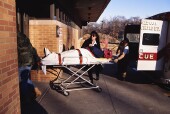
TUESDAY, Sept. 13 (HealthDay News) — Teenagers may complain about so-called graduated driver licensing laws — which require young drivers to gain driving experience in low-risk situations before obtaining full driving privileges — but a new study shows that they dramatically reduce fatal crashes among 16-year-olds.
However, the same study found that the graduated driver licensing (GDL) laws don’t have the same effect on 18-year-old drivers. The rate of fatal crashes increased slightly in states with the strictest laws.
“The finding that’s of the most interest is that states where GDL laws are the strongest were associated with a 26 percent reduction in fatal crashes in 16-year-olds,” said the study’s lead author, Scott Masten, a research manager in the research and development branch at the California Department of Motor Vehicles in Sacramento.
“But, in those same areas, there was also a 12 percent increase in the number of fatal crashes for 18-year-old drivers,” said Masten, who began this research as part of his doctoral dissertation while at the University of North Carolina at Chapel Hill.
Results of the study are published in the Sept. 14 issue of the Journal of the American Medical Association.
Most graduated licensing programs include a beginner stage (supervised driving, culminating in a driving test), intermediate stage (which restricts unsupervised driving in high-risk situations such night travel) and the “full privileges” stage (standard driving license). GDL laws have been adopted in all states and in the District of Columbia, but program requirements vary. Some allow teens under 18 to graduate to a full license, but only after they’ve completed a lengthy driver education program.
Intermediate licenses (between a learner’s permit and a full license) often allow teens to drive unsupervised, but limit a teen to day-time driving and may restrict the number of passengers a teen may have in the car. Many states also ban all cell phone use for beginning drivers.
For the study, the researchers reviewed crash data from all 50 states and the District of Columbia. Between 1986 and 2007, they found more than 130,000 fatal crashes with a teen driver at the wheel, Masten said.
They then adjusted the data to try to account for other factors that might have affected the fatal crash rates, such as new laws on driving while intoxicated and seatbelts.
Overall, they found that fatal crashes tend to go up with teen drivers’ age. They found 28.2 fatal crashes per 100,000 person-years for 16-year-olds, 36.9 for 17-year-olds, and 46.2 per 100,000 person-years for 18-year-olds. Once teens hit 19-years-old, the rate went down to 44.
Masten said he could only speculate as to why fatal crash rates were higher for 18-year-olds. One theory is that because many teens delay getting their licenses until they’re older, 18-year-olds today don’t have the same amount of driving experience as they did in the past.
“I think they did a very complicated analysis in this study, and their results are dissimilar to other findings from the Insurance Institute for Highway Safety that showed some advantage for 18-year-olds,” said Susan Baker, a professor at the Johns Hopkins Center for Injury Research and Policy in Baltimore, Md. She added that it’s very difficult to compare GDL programs from state to state, because each state has its own set of rules.
Baker noted that the unadjusted data showed a reduction in the number of fatal crashes for both 16- and 18-year-olds.
Both experts agreed that GDL laws reduce the number of fatal crashes, which are the leading cause of teenage deaths in the United States, and both said that the stronger GDL laws appear to be the most effective. Stronger programs included restrictions on both nighttime driving and the number of passenger.
Baker said she’d love to see all states adopt laws similar to those in New Jersey, where anyone 21 and younger must go through a graduated licensing program. Age isn’t an automatic determinant of getting your license; driving experience is, she noted.
And, for parents of new drivers, Masten had this advice: “State laws are minimums. You can have your own graduated licensing program at home. If they’re still at home, you can have your rules and restrictions.”
More information
Learn more about each state’s graduated licensing program from the Governors’ Highway Safety Administration.

